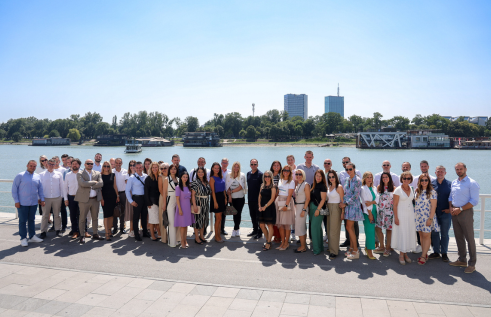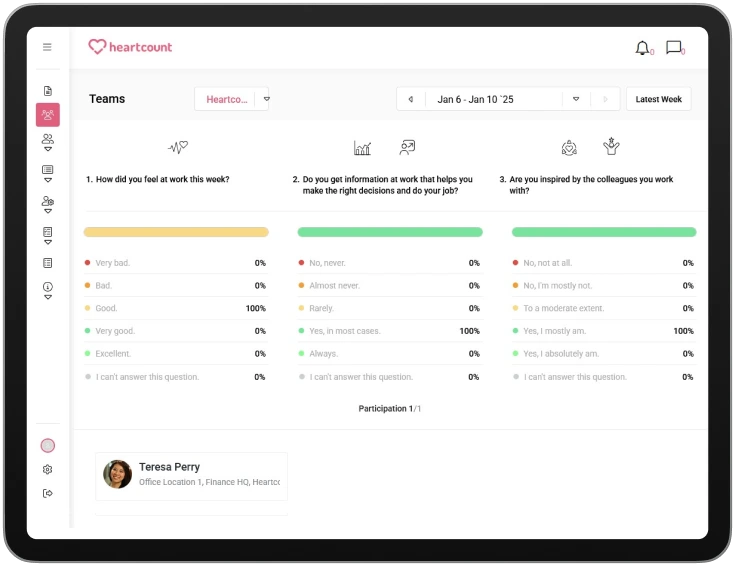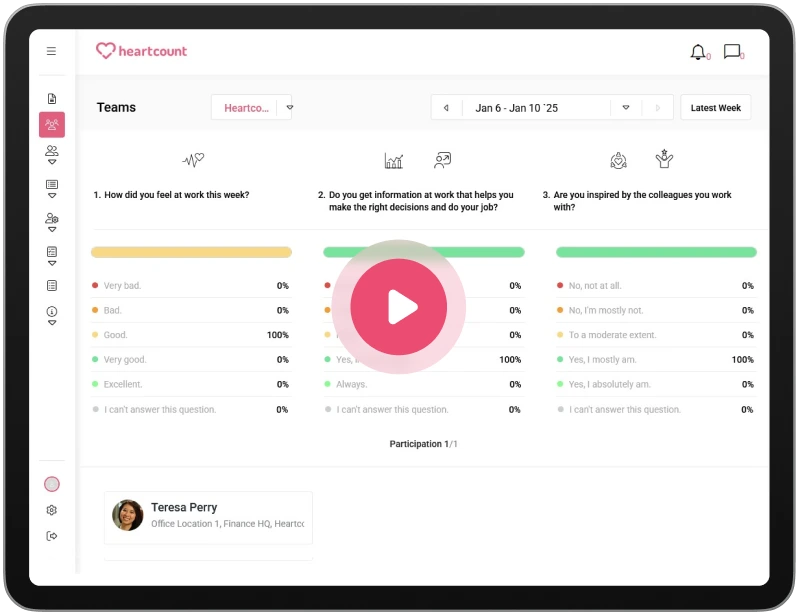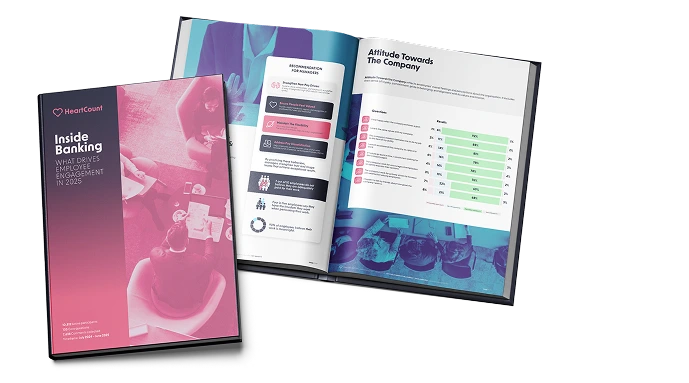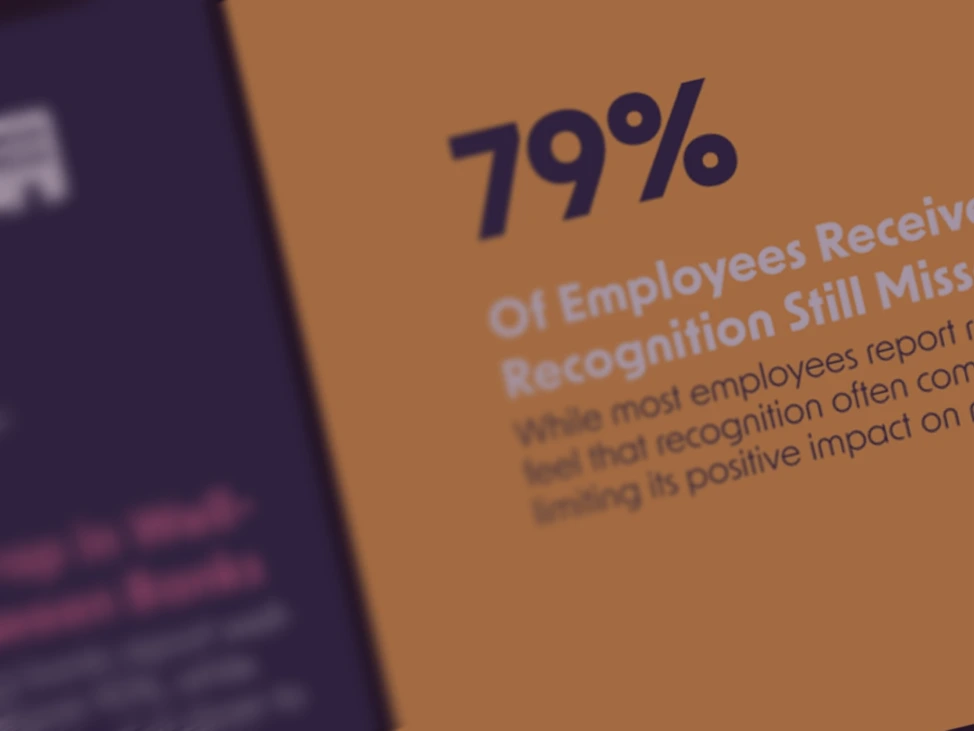Happiness at Workplace: What Drives It, Why It Matters, and How to Build It in 2025

What if the key to higher productivity, lower turnover, and stronger culture wasn’t in a new strategy—but in how people feel on Monday morning?
According to a study from the University of Oxford, happy employees are 13% more productive than their less satisfied peers. Meanwhile, companies that invest in emotional wellbeing report significant gains in creativity, collaboration, and retention. In 2025, happiness at work is more than a feel-good initiative – it’s a strategic advantage.
And yet, many organisations still struggle to define, measure, and act on what truly drives employee happiness.
That’s where platforms like HeartCount come in – helping HR leaders, managers, and culture teams move from assumptions to insights with real-time sentiment data and weekly feedback loops.
In this guide, we explore what drives happiness at work, why it matters more than ever, and how to build a culture where both people and business can thrive.
-
1.Why Happiness at Work Is a Business Priority – Not a Perk
-
2.What Makes People Happy at Work?
-
3.What Causes Unhappiness in the Workplace?
-
4.How to Measure Workplace Happiness (Surveys and Beyond)
-
5.The HeartCount Loop: Listen → Diagnose → Act → Track
-
6.7 Practical Ways to Build a Happier Workplace (With Examples)
-
7.Happiness at Work in Hybrid & Remote Teams
-
8.FAQ: Happiness at Workplace, Answered
What if the key to higher productivity, lower turnover, and stronger culture wasn’t in a new strategy—but in how people feel on Monday morning?
According to a study from the University of Oxford, happy employees are 13% more productive than their less satisfied peers. Meanwhile, companies that invest in emotional wellbeing report significant gains in creativity, collaboration, and retention. In 2025, happiness at work is more than a feel-good initiative – it’s a strategic advantage.
And yet, many organisations still struggle to define, measure, and act on what truly drives employee happiness.
That’s where platforms like HeartCount come in – helping HR leaders, managers, and culture teams move from assumptions to insights with real-time sentiment data and weekly feedback loops.
In this guide, we explore what drives happiness at work, why it matters more than ever, and how to build a culture where both people and business can thrive.
Why Happiness at Work Is a Business Priority – Not a Perk
In 2025, happiness at workplace is no longer a “nice-to-have.” It’s a measurable business asset – one that directly impacts productivity, retention, and organisational resilience. While it’s easy to assume that happy workers simply enjoy better moods or friendlier interactions, the effects run deeper and wider.
Today’s best-performing organisations understand that employee happiness is intertwined with innovation, performance, and even customer satisfaction. As labour markets tighten and hybrid models become standard, businesses that prioritise emotional wellbeing are better positioned to attract top talent and sustain long-term growth.
The ROI of Happy Employees: Productivity, Retention, and Profitability
The benefits of happy employees are both human and financial. According to Gallup, business units with high employee wellbeing see up to 21% greater profitability, 41% lower absenteeism, and 17% higher productivity. That’s not just correlation—it’s causation built on emotional engagement.
Happy employees are more likely to:
- Stay longer, reducing costly turnover.
- Show up fully and consistently.
- Collaborate across teams more effectively.
- Recommend their company to others—becoming informal brand ambassadors.
In contrast, low morale often leads to hidden costs: quiet quitting, reduced innovation, and loss of internal trust. That’s why workplace happiness has moved from a culture conversation to a strategic imperative.
Key Statistics on Workplace Happiness (2025)
New research continues to validate the strong link between employee happiness and business outcomes:
- As we mentioned previously, in the study by the University of Oxford, it was found that happy workers are 13% more productive, especially in high-pressure environments like call centres. They made more calls per hour and achieved better conversion rates.
- Economists at the University of Warwick concluded that happy employees are 12% more productive, while unhappy ones are up to 10% less effective.
- According to AIHR, companies that actively measure and respond to employee sentiment see up to 18% greater productivity, 40% lower turnover, and up to 250% revenue growth.
These aren’t vanity metrics – they’re early indicators of organisational health. Emotional wellbeing at work impacts performance just as much as skills or systems.
That’s where platforms like HeartCount come in, providing real-time insight into how people feel, why they feel that way, and what you can do about it. By combining weekly sentiment snapshots with predictive analytics and automated nudges for managers, HeartCount helps organisations act quickly and meaningfully on what truly drives performance.
How CHROs and HR Teams Use Happiness Metrics Strategically
For modern HR and People Ops teams, workplace happiness is more than a vibe check. It’s a leading indicator used to:
- Anticipate disengagement and prevent burnout before it spikes
- Justify budget allocation for wellness, learning, and culture initiatives
- Benchmark teams, departments, or offices against one another
- Identify high-performing managers who foster emotionally intelligent environments
By leveraging platforms that offer weekly pulse surveys and sentiment analytics—like HeartCount’s employee experience tools—HR leaders can shift from reactive problem-solvers to proactive culture architects.
When used strategically, happiness metrics don’t just explain what’s happening—they empower you to act fast, with confidence.
What Makes People Happy at Work?
Understanding what makes a happy workplace isn’t guesswork – it’s supported by clear trends and data. While salary and perks still matter, long-term employee happiness is primarily driven by emotional and psychological factors like recognition, trust, and autonomy.
Recognition and Psychological Safety
People feel happiest when their efforts are acknowledged and when they can speak freely without fear of judgment. Recognition, especially when embedded into daily workflows, boosts both morale and performance. At the same time, psychological safety enables open communication and innovation.
Creating this sense of inclusion is central to building a culture of belonging, where individuals are valued not just for output but for who they are.
Autonomy, Purpose, and Growth Opportunities
Happy workers are those who have ownership over their tasks and understand how their role contributes to something meaningful. This sense of purpose deepens when people are given the freedom to shape how they work, combined with access to development pathways.
Clear growth conversations and feedback cycles are essential here. Managers who know how to give feedback to employees in a timely, structured way are far more likely to retain and motivate their teams.
Flexibility and Work-Life Balance
Workplace happiness rises significantly when people are trusted to choose when and where they work best. Companies that support this flexibility without micromanagement see lower stress levels and higher engagement.
Flexible policies work best when paired with systems that track sentiment and flag early signs of imbalance—especially in remote settings. Tools like automated employee pulse check surveys help organisations keep a weekly pulse on how people are really doing.
Transparent Communication and Trust in Leadership
Trust in leadership plays a decisive role in shaping employee happiness. When leaders communicate clearly, involve employees in decisions, and follow through on commitments, teams feel safer and more aligned.
Transparent workplaces—those with visible goals, open feedback loops, and honest updates—report significantly stronger retention and morale. You can see how this plays out in practice in HeartCount’s post on workplace transparency.
Physical Environment and Hybrid Preferences
Even in 2025’s hybrid-first world, the physical space we work in still affects our well-being. Light, noise, privacy, and ergonomic design all influence daily mood and focus.
What truly boosts happiness, however, is offering flexibility to choose the right environment for the right task. Platforms that offer a central employees overview make it easier for managers to understand what each person needs—wherever they work.
COLLECT
What Causes Unhappiness in the Workplace?
If we want to build happier teams, we also need to understand what leads to dissatisfaction. It’s rarely caused by one dramatic event. More often, unhappiness grows quietly through a combination of vague expectations, inconsistent leadership, and overlooked day-to-day needs.
Some workplace issues don’t directly increase happiness when present, but their absence creates an immediate sense of instability or frustration. These are not motivational drivers. They are the baseline conditions employees rely on to feel secure, respected and able to do their jobs properly.
For example, when expectations are unclear, people often feel lost or anxious about whether they’re focusing on the right things. If they don’t have the resources or tools they need, even simple tasks become tiring. Poor management, whether through micromanagement, lack of direction or disrespect, can quickly erode trust.
Inadequate pay is another common source of dissatisfaction. Most people don’t work solely for money, but feeling underpaid or financially insecure is a persistent stressor. Job insecurity has a similar effect, making it hard to stay focused or motivated when people are worried about sudden changes.
A lack of recognition also plays a role. When consistent effort goes unnoticed, employees may start to question the point of their contributions. Finally, a toxic workplace culture, where there’s favouritism, exclusion, or unresolved conflict, can demoralise even the most committed team members.
These aren’t the things that make people fall in love with their jobs. But without them, it becomes nearly impossible for anyone to feel engaged or energised at work.
Common Hidden Drivers of Disengagement
Many signs of unhappiness at work are subtle. Missed deadlines, low participation in meetings, or a sudden drop in feedback can point to a deeper issue. These behaviours often stem from a lack of connection, recognition, or clarity—not laziness.
Chronic disengagement may start as silence but eventually leads to turnover, presenteeism, or quiet quitting. In fact, the early warning signs of being unhappy at work are frequently emotional—things like feeling invisible, excluded, or uncertain about purpose.
Manager Behaviours That Erode Morale
Even well-meaning managers can unintentionally harm morale. Micromanagement, inconsistent feedback, or failing to recognise effort can lead to frustration and disengagement.
More damaging, however, are subtle trust-breakers: taking credit, withholding context, or avoiding difficult conversations. These behaviours weaken the psychological contract between teams and leadership—undermining the employee happiness you’ve worked to build.
That’s why building emotional intelligence and real-time visibility into team sentiment is so important.
Systemic Issues: Burnout, Overload, and Culture Debt
Some causes of unhappiness are embedded in how the organisation operates. Unmanageable workloads, poor prioritisation, and lack of recovery time create conditions for burnout—a state of emotional exhaustion that kills motivation at the root.
When left unaddressed, burnout becomes cultural: meetings multiply, urgency becomes the norm, and healthy boundaries disappear. This is what some call “culture debt”—the invisible cost of not designing for sustainability.
To understand how to spot and solve these systemic issues, HeartCount breaks down the core burnout causes and cures you need to know in 2025.
How to Measure Workplace Happiness (Surveys and Beyond)
You can’t improve what you don’t measure. While workplace happiness might seem subjective, it can be tracked through consistent, intentional feedback mechanisms—especially when tied to behavioural indicators like engagement, participation, and sentiment trends.
Pulse Surveys vs. Annual Surveys: What’s More Effective?
Traditional annual surveys offer a broad snapshot, but they often arrive too late to spark meaningful change. By the time results are analysed and shared, teams may have already disengaged or moved on.
In contrast, pulse surveys offer real-time visibility into what employees are thinking and feeling—week by week. They help surface patterns before they become problems, and they enable fast feedback loops between employees and leadership.
HeartCount’s automated pulse check surveys allow organisations to track emotional trends continuously, offering quick-read signals across departments or locations.
Still, surveys are just one part of the picture. Listening also means capturing nonverbal cues: drop-offs in initiative, sudden silences, or emotional language in comments.
Key Metrics to Track: Motivation, Autonomy, Emotional Exhaustion
To build a consistently happy workplace, it’s not enough to track general satisfaction. The most meaningful insights come from understanding what truly drives engagement and wellbeing over time. HeartCount’s six-month report focuses on three core dimensions:
- Motivation – The drive employees feel to take initiative and stay committed. Both intrinsic and extrinsic motivators influence this score and play a central role in overall engagement.
- Autonomy – A sense of ownership and control over one’s work. When employees are trusted to make decisions, they’re more satisfied, productive, and less likely to disengage or leave.
- Emotional exhaustion – A measure of how depleted employees feel at work. This metric is reverse-coded, so higher scores indicate lower levels of exhaustion and a more sustainable work environment.
Together, these three metrics offer a clear picture of the emotional and behavioural dynamics shaping your workplace. If you’re looking to explore how to measure these areas effectively, take a look at HeartCount’s guide to employee happiness surveys.
The HeartCount Loop: Listen → Diagnose → Act → Track
At the core of sustainable happiness at workplace is not just measurement—but action. That’s why HeartCount is built around a continuous improvement model that helps teams respond in real time. The loop is simple but powerful: Listen → Diagnose → Act → Track.
Listen: Using Pulse Surveys to Capture Weekly Sentiment
Weekly pulse surveys give organisations a dynamic window into how employees feel—without overwhelming them with long questionnaires. These short, focused check-ins provide quick sentiment snapshots that reveal patterns early and often.
The advantage isn’t just frequency—it’s consistency. By making listening a habit, teams normalise feedback and reduce emotional bottlenecks.
Diagnose: Spot Burnout, Attrition Risk, and Team Friction Early
Once feedback is collected, the next step is pattern recognition. HeartCount’s platform uses AI-powered risk scoring to flag burnout signals, disengagement, or signs of team-level friction. This gives HR and managers the opportunity to intervene proactively—before problems escalate.
Predictive analytics enable CHROs to go beyond guesswork and target their time, budget, and attention where it matters most.
Act: Templates and Manager Nudges That Drive Change
Data alone doesn’t build a better culture—action does. HeartCount supports managers with ready-to-use conversation templates, automated nudges, and team insights designed to make change easy and timely.
Instead of waiting for HR to own every feedback loop, managers are empowered to respond within their own teams—closing the gap between insight and improvement.
If you’re building manager accountability into your culture strategy, check out our broader perspective on how to drive employee engagement.
Track: How to Monitor Progress and Close the Feedback Loop
Finally, tracking allows organisations to see what’s working. Over time, changes in sentiment, engagement, and morale highlight the effectiveness of interventions—whether that’s a new policy, recognition initiative, or leadership shift.
With dashboards that visualise feedback trends, HeartCount makes it easier to show ROI and report on cultural progress to leadership teams.
This continuous loop ensures that employee happiness isn’t treated as a one-off initiative—but as a strategic, measurable process that adapts in real time.
UNDERSTAND
7 Practical Ways to Build a Happier Workplace (With Examples)
While strategy and metrics matter, workplace happiness is ultimately shaped by everyday actions. The most effective teams don’t rely on one-off wellness initiatives—they embed happiness into routines, rituals, and responsibilities.
Here are seven practical, evidence-based ways to create a culture where happy employees thrive.
1. Embed Recognition into Daily Routines
Don’t save praise for annual reviews. Real-time, peer-driven recognition helps people feel seen and valued. Whether it’s a quick kudos message or a structured “shoutout” channel, frequent positive feedback builds trust and connection.
HeartCount enables this through its real-time kudos feed, turning recognition into a habit—not a special occasion.
2. Give Managers Real-Time Nudges Based on Team Sentiment
Managers often want to support their teams but lack visibility into how people are actually feeling. That’s why automated nudges based on weekly sentiment data are so effective—they prompt timely check-ins, not reactive ones.
This bridges the gap between feedback and action, especially in busy or distributed teams. Employee experience platforms that surface this data in digestible ways make it easy for managers to step up without being overwhelmed.
3. Offer Career Growth Paths and Mentorship Access
One of the clearest benefits of happy employees is lower turnover. People who see a future for themselves at your company are more likely to stay and contribute meaningfully.
Make career development visible: outline clear growth tracks, pair people with mentors, and support internal mobility. These efforts directly strengthen both retention and engagement, as explored in HeartCount’s post on employee engagement and retention. Small moves like these reinforce that you’re invested in their long-term success.
4. Run “Belonging Audits” Quarterly
Belonging isn’t a soft concept—it’s measurable. Audit team dynamics every quarter: Who speaks up? Who stays silent? Who’s left out of informal networks?
Use both survey data and manager observations to identify gaps and biases. This proactive approach helps cultivate an environment where everyone can contribute fully.
5. Provide Flexible Work Options That Match Personas
A one-size-fits-all hybrid policy is no longer enough. People have different needs based on role, life stage, and personality. Let your flexibility reflect that.
Create working models around personas—not just policies. Some thrive in-office, others need focus time at home. Happy teams are those that are trusted to choose the best environment for their work.
6. Encourage Breaks and Time Off That’s Actually Taken
Encouraging PTO is one thing—making it culturally safe to take it is another. Role-model time off, discourage always-on behaviour, and avoid rewarding burnout.
Even micro-breaks during the workday matter. Encourage “do-not-disturb” windows and break rituals. When leaders prioritise wellbeing, teams feel permission to follow.
7. Build Rituals That Bond Remote and Hybrid Teams
Shared rituals create rhythm and connection. From weekly win roundups to digital coffee chats, consistent team traditions reduce isolation and foster belonging—even when people are miles apart.
These rituals work best when shaped by the team, not just leadership. Invite input, rotate ownership, and keep it light. Small moments of joy drive long-term employee happiness.
Happiness at Work in Hybrid & Remote Teams
Remote and hybrid work models are no longer experimental—they are reshaping what happiness at workplace looks like in 2025. Flexibility, autonomy, and trust have become central pillars of emotional wellbeing, especially for distributed teams.
Research from Stanford University found that employees on a hybrid schedule (two days working from home) maintained equal promotion and productivity levels, while reducing turnover by 33%. These findings reflect what many organisations are discovering: hybrid models support both wellbeing and performance.
Similarly, a UK-wide survey by Mortar Research revealed that 86% of hybrid workers reported better work-life balance, while 74% felt less drained and 78% experienced less stress—clear indicators of improved employee happiness.
Meanwhile, the 2025 State of Remote Work Report by Neat found a 35–40% productivity boost among remote-capable employees, largely driven by fewer distractions and greater focus in home-based settings.
Despite these benefits, hybrid models bring new challenges—particularly around visibility and connection. Disengagement is harder to detect when employees aren’t physically present. That’s why tools like automated employee pulse check surveys are crucial for spotting early sentiment shifts in distributed teams.
What makes people happy at work in hybrid setups isn’t just the ability to work remotely—it’s having the structure, culture, and leadership practices that support autonomy without isolation. Regular manager check-ins, virtual rituals, shared recognition, and asynchronous communication all help preserve belonging.
ACT
FAQ: Happiness at Workplace, Answered
What Makes a Happy Workplace?
A happy workplace is one where employees feel valued, supported, and trusted. It includes clear communication, recognition, opportunities for growth, and a culture that respects individual needs and contributions. Psychological safety and a sense of purpose also play a key role.
How Do You Measure Employee Happiness?
Employee happiness can be measured through regular pulse surveys, one-on-one conversations, and behavioural indicators such as engagement, participation, and feedback patterns. Tracking changes over time helps identify trends and areas for improvement.
What Are the Signs of an Unhappy Workforce?
Early signs include emotional withdrawal, increased absenteeism, low morale, poor collaboration, and decreased productivity. Unhappy employees may also disengage silently—by reducing their input, avoiding feedback, or showing signs of burnout.
How Can Managers Improve Workplace Happiness?
Managers can improve workplace happiness by recognising contributions regularly, encouraging open dialogue, supporting career development, respecting boundaries, and modelling positive behaviour. Small, consistent actions often have the biggest impact.
What’s the Difference Between Engagement and Happiness?
Engagement refers to how involved and committed employees are to their work and goals, while happiness reflects their overall emotional wellbeing at work. Engaged employees aren’t always happy—and happy employees aren’t always highly engaged—but both are essential for long-term performance and retention.




